BURMAH
Burmah/Major/Apex, Trading
Brief History
The Burmah Oil Company Ltd was founded in Glasgow, Scotland in 1886 to develop oil interests in the Indian sub-continent. It became an early and major shareholder in BP, so restricted its downstream interests to the sub-continent, where BP had no business. Marketing was under the BOC brand in Burma, East Pakistan and Assam (India) and through a joint venture with Shell in the rest of India and West Pakistan.
|
By the 1960s, Burmah realised that it had to diversify to survive. Its first move was to buy Castrol - Europe's leading independent lubricant manufacturer - in 1966, followed soon after by Lobitos Refineries. Lobitos retailed petrol on the Pacific Coast of South America and had 229 service stations in Ireland and NW England. In 1969 a new red, white and blue Burmah logo was introduced on these stations. Burmah added to its chain by acquiring the discounter Curfew in 1968 and Major and Apex in 1969. Curfew's 135 outlets were rapidly replaced by Burmah but Major, which was established in 1856 and started selling petrol in 1926, was kept as a secondary brand in the North East and E Midlands until 1995. Apex was also retained for nearly 20 years, as it had a distinctive market profile being the first UK chain to only operate self service stations and to use exclusively female assistants. |
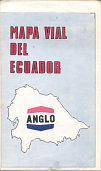
|
A 1969 Anglo map (right) of Ecuador shows how Burmah's hexagon logo incorporated local brands. | |
A proposed merger with Conoco was never consummated in 1970, and over expansion in shipping led to near bankruptcy and the sale of its BP stake to the UK Government at a depressed price in 1974.
European expansion soon followed with Trading in Belgium and Holland - the latter country switching to the Burmah brand for a few years - and Uno-X in Sweden. In Belgium, Trading later switched most of its stations to Aral, selling the rump chain to BP; Burmah then bought back 250 of BP's outlets in the 1990s and introduced the Burmah name to Belgium. Uno-X had been established in Denmark in 1956, but the Swedish company was sold to Burmah in 1970. It sold its Northern stations to BP, but later bought more sites back from BP. The largest UK acquisition was the 450 ICI Petrol outlets bought in 1988. Burmah's South American interests were sold in the early 1970s, although it bought into the Comar chain in Chile a decade later. The 1980s also saw acquisitions in Turkey (Turkpetrol) and Australia (Astron).
Petroleum fuels had always sat uneasily within Burmah's portfolio of lubricants and industrial chemicals. In the 1990s all fuels retailing was sold, with Britain going to the Frost Group under its SAVE brand, and Norsk Hydro re-unifying Uno-X by buying the Swedish chain in 1996. Belgium passed to the independent Octa+, Turkey and Chile were sold to joint venture partners and in 1999 Ireland was sold to EMO, leaving only Australia. In March 2000 BP Amoco agreed to buy Burmah, although by then all fuels operations had been disposed of.
Maps: Burmah
Because most of the chains acquired by Burmah were small, few issued maps or had large service stations likely to sell many maps. As a result all group maps are relatively uncommon. Uno-X maps are shown on the page of Hydro, the final owner of the brand.
|
|
|
|
In the UK there were three series of Burmah branded maps; the older two were undated and drawn by Map Productions Ltd and suffer from being printed on poor quality paper, but both probably come from the 1970s. The earlier one (far left) had five sections, omitted Ireland and was produced in two editions, before and after 1971. The final series, produced by Geographia Ltd in 1980, used different pictures for each section and showed all 3 logos then in use: Burmah, Apex & Major. |

|
Burmah's strongest European markets were in Ireland, North and South, where it respectively bought the Lobitos and Shamrock chains. Sometime in the late 1960s it produced a map of all Ireland (above right), with cartography by Map Productions Ltd, proclaiming Burmah to be the "big new name in petrol". This is the only known Burmah map of Ireland produced outside the UK series, even though they distributed petrol in Ireland for over 30 years, before the chain was sold to the Irish company Emo.
Burmah image courtesy of Richard Horwitz
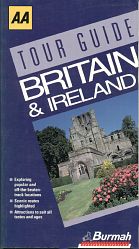 |
Burmah produced no sheet maps in its last 15 years in Britain. However it did commission the AA to prepare a special version of its Tour Guide to Britain & Ireland, which includes some 35 tour maps. This is the only map-related item bearing the chinth logo.
|
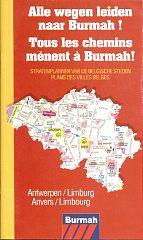 |
Maps: Trading
 Trading was an independent Belgian distributor of petrol and oil based - like many other smaller Belgian brands - in Antwerp and had a small chain in Holland. In the late 1960s, Burmah acquired the bulk of Trading, changing the Dutch chain to the Burmah brand, and redesigning the Trading logo to mirror the Burmah hexagon. A deal with Aral led to most Trading stations switching to the Aral brand in exchange for Aral stations across Europe selling Castrol oils. Some of Trading's operations later ended up with under BP's ownership, before being sold back to Burmah along with 250 smaller BP branded service stations; these were switched to the Burmah brand in the 1990s before being sold to Octa+ shortly before the parent company was itself bought by BP.
Trading was an independent Belgian distributor of petrol and oil based - like many other smaller Belgian brands - in Antwerp and had a small chain in Holland. In the late 1960s, Burmah acquired the bulk of Trading, changing the Dutch chain to the Burmah brand, and redesigning the Trading logo to mirror the Burmah hexagon. A deal with Aral led to most Trading stations switching to the Aral brand in exchange for Aral stations across Europe selling Castrol oils. Some of Trading's operations later ended up with under BP's ownership, before being sold back to Burmah along with 250 smaller BP branded service stations; these were switched to the Burmah brand in the 1990s before being sold to Octa+ shortly before the parent company was itself bought by BP.
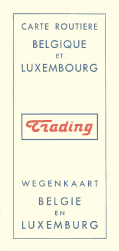 |
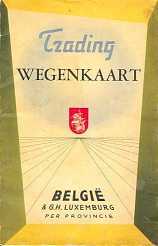
|

|
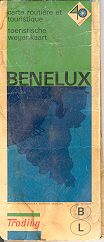 |
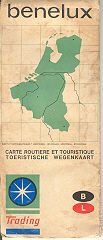 |
Trading's first known map, dating from the early 1950s, is the simple one shown above left with cartography by de Ruycker at 1:400,000, covering just Belgium. It then produced a quite complex atlas of Belgium by province around 1953 featuring the Trading clipper that was also used on its oil cans. This full colour production carried many adverts for Trading's products, and was available in French and Dutch (shown above) versions.
The next three Trading maps shown above date from the early 1960s and cover all of Benelux. Each cover has B L in an arrow or ovals to signify Belgium and Luxembourg; the reverse side has NL for the map of the Netherlands. (In fact the maps lack enough overlap to do this properly: Maastricht falls on the Belgian side.) The first is described as a Trading Week-end map, with cartography by Bootsma (Falk) at 1:600,000. The next two are dated 1962 and 1964 and were both prepared by Mantnieks Brussels at 1:500.000 under a light card cover.
Trading later sold a Kümmerley & Frey road atlas of Europe with plain green vinyl covers embossed with a small gold "Trading" and the logo printed on the flysheet. No Burmah "hexagon" maps are known for Trading (or the Dutch Burmah chain).
The oldest known Burmah "map" is a sponsored book of the roads of Burma, issued in 1948 with rudimentary maps marking towns where Burmah products were on sale. Elsewhere in sub-continent, Burmah-Shell issued a map of Delhi. Burmah also produced maps for a South American subsidiary using the "Anglo" brand in Ecuador around 1970 and, prior to its purchase by Burmah, Lobitos is known to have produced a map of Peru in 1963. No examples are known from Burmah group companies in Turkey, Chile, Australia or the Republic of Ireland.
Special thanks to Michel Breugelmans for his help with the Trading section this page.
Text and layout © Ian Byrne, 1999-2012
All original copyrights in logos and map extracts and images are acknowledged and images are included on this site for identification purposes only.




